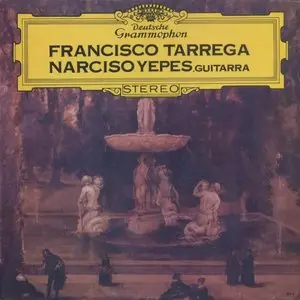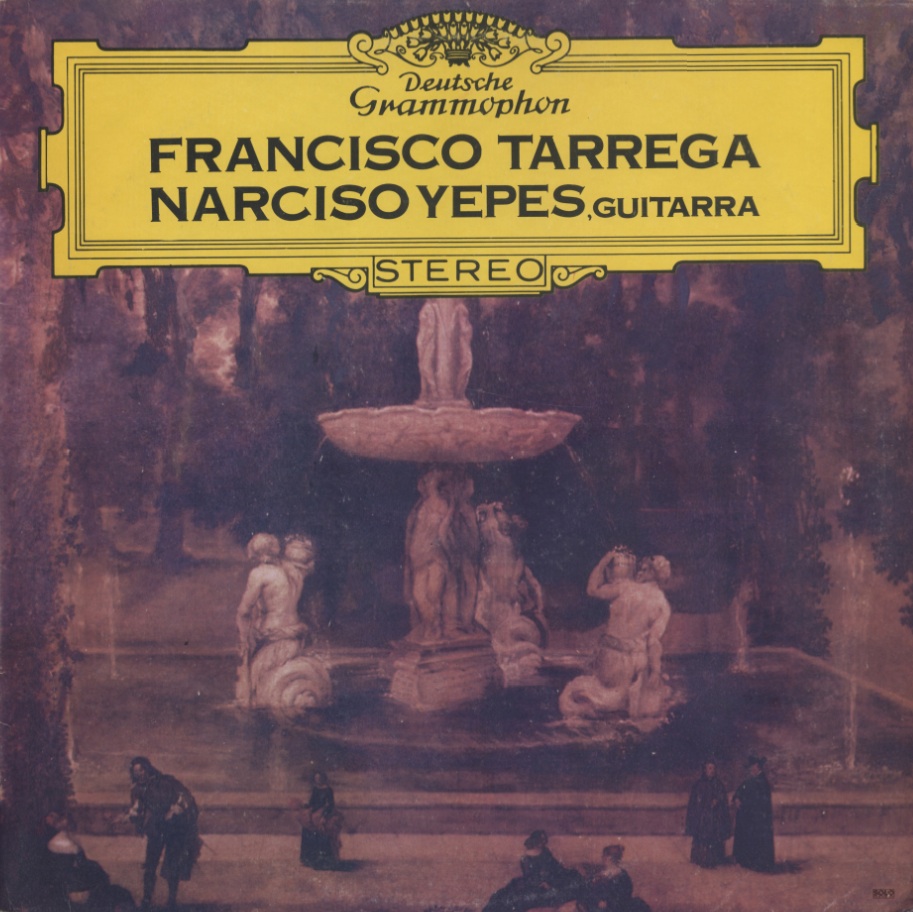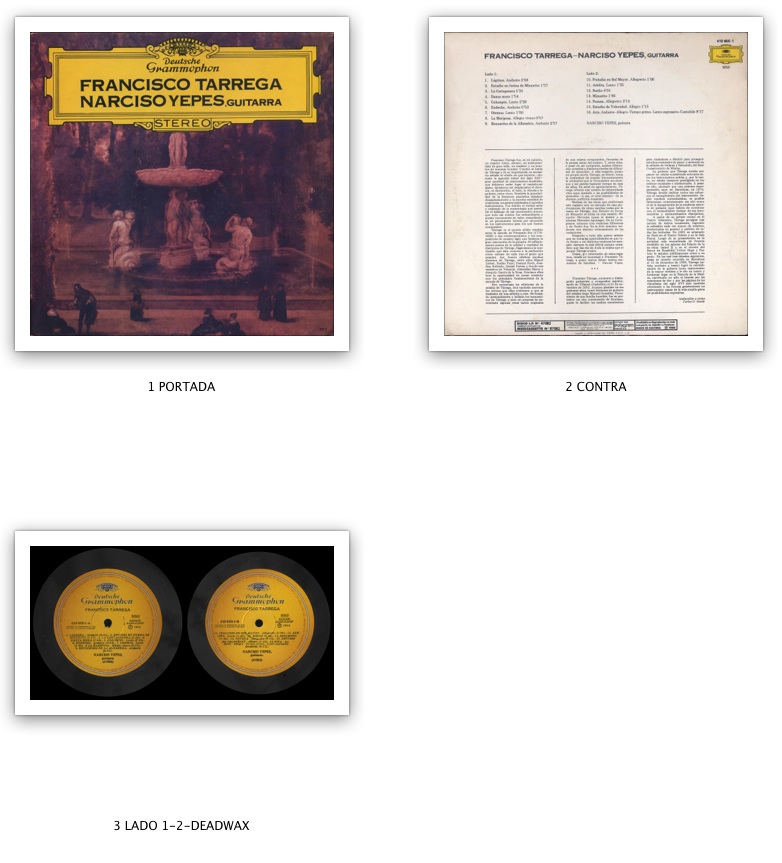Narciso Yepes - Francisco Tárrega
Vinyl | LP Cover (1:1) | FLAC + cue | 24bit/96kHz | 900mb
Label: Deutsche Grammophon/410 655-1 | Released: 1983 | Genre: Classical-Guitar
A1 Lágrima. Andante 2:08
A2 Estudio In Forma De Minuetto 1:57
A3 La Cartagenera 5:25
A4 Danza Mora 1:54
A5 Columpio. Lento 2:26
A6 Endecha. Andante 0:53
A7 Oremus. Lento 1:00
A8 La Mariposa. Allegro Vivace 0:57
A9 Recuerdos De La Alhambra. Andante 2:57
-
B1 Preludio In G Major. Allegretto (En Sol Majeur/G-dur) 1:06
B2 Adelita. Lento 1:35
B3 Sueño 4:55
B4 Minuetto 1:46
B5 Pavana. Allegretto 2:14
B6 Estudio De Velocidad. Allegro 1:15
B7 Jota. Andante - Allegro - Tempo Primo - Lento, Espressivo - Cantabile 9:17
Phonographic Copyright (p) – Polydor International GmbH
Recorded At – Zentralsaal, Bamberg
Credits
Composed By – Francisco Tárrega
Engineer – Hans-Rudolf Müller, Heinz Wildhagen
Guitar – Narciso Yepes
Producer – Steven Paul
Notes
Recording: Bamberg, Zentralsaal, 09/1982
(p) 1983 Polydor International GmbH, Hamburg - © 1983 Narciso Yepes
Vinyl | LP Cover (1:1) | FLAC + cue | 24bit/96kHz | 900mb
Label: Deutsche Grammophon/410 655-1 | Released: 1983 | Genre: Classical-Guitar
A1 Lágrima. Andante 2:08
A2 Estudio In Forma De Minuetto 1:57
A3 La Cartagenera 5:25
A4 Danza Mora 1:54
A5 Columpio. Lento 2:26
A6 Endecha. Andante 0:53
A7 Oremus. Lento 1:00
A8 La Mariposa. Allegro Vivace 0:57
A9 Recuerdos De La Alhambra. Andante 2:57
-
B1 Preludio In G Major. Allegretto (En Sol Majeur/G-dur) 1:06
B2 Adelita. Lento 1:35
B3 Sueño 4:55
B4 Minuetto 1:46
B5 Pavana. Allegretto 2:14
B6 Estudio De Velocidad. Allegro 1:15
B7 Jota. Andante - Allegro - Tempo Primo - Lento, Espressivo - Cantabile 9:17
Phonographic Copyright (p) – Polydor International GmbH
Recorded At – Zentralsaal, Bamberg
Credits
Composed By – Francisco Tárrega
Engineer – Hans-Rudolf Müller, Heinz Wildhagen
Guitar – Narciso Yepes
Producer – Steven Paul
Notes
Recording: Bamberg, Zentralsaal, 09/1982
(p) 1983 Polydor International GmbH, Hamburg - © 1983 Narciso Yepes
This Rip: 2015
Cleaning: RCM Moth MkII Pro Vinyl
Direct Drive Turntable: Marantz 6170
Cartridge: SHURE M97xE With JICO SAS Stylus (New!)
Amplifier: Sansui 9090DB
ADC: E-MU 0404
DeClick with iZotope RX3 & ClickRepair: Only Manual (Click per click)
Vinyl Condition: M
This LP: From my personal collection
LP Rip & Full Scan LP Cover: Fran Solo
Password: WITHOUT PASSWORD
Yepes was born into a family of humble origin in Lorca, Region of Murcia. His father gave him his first guitar when he was four years old, and brought the boy five miles on a donkey to and from lessons three days a week. He took his first lessons from Jesus Guevara, in Lorca. Later his family moved to Valencia when the Spanish Civil War started in 1936.
When he was 13, he was accepted to study at the Conservatorio de Valencia with the pianist and composer Vicente Asencio. Here he followed courses in harmony, composition, and performance. Yepes is credited by many with developing the A-M-I technique of playing notes with the ring (Anular), middle (Medio), and index (Indice) fingers of the right hand.[1] Guitar teachers traditionally taught their students to play by alternating the index and middle fingers, or I-M. However, since Yepes studied under teachers who were not guitarists, they pushed him to expand on the traditional technique. According to Yepes, Asencio "was a pianist who loathed the guitar because a guitarist couldn't play scales very fast and very legato, as on a piano or a violin. 'If you can't play like that,' he told me, 'you must take up another instrument.'" Through practice and improvement in his technique, Yepes could match Asencio's piano scales on the guitar. "'So,' he [Asencio] said, 'it's possible on the guitar. Now play that fast in thirds, then in chromatic thirds.'"[2] Allan Kozinn observed that, "Thanks to Mr. Asencio's goading, Mr. Yepes learned "to play music the way I want, not the way the guitar wants."[3] Similarly, the composer, violinist, and pianist George Enescu would also push Yepes to improve his technique, which also allowed him to play with greater speed.[4]
On 16 December 1947 he made his Madrid début, performing Joaquín Rodrigo's Concierto de Aranjuez with Ataúlfo Argenta conducting the Spanish National Orchestra. The overwhelming success of this performance brought him renown from critics and public alike. Soon afterwards, he began to tour with Argenta, visiting Switzerland, Italy, Germany and France. During this time he was largely responsible for the growing popularity of the Concierto de Aranjuez, and made two early recordings, both with Argenta[5] – one in mono with the Madrid Chamber Orchestra (released between 1953 and 1955),[6] and the second in stereo with the Orquesta Nacional de España (recorded in 1957 and released in 1959).[7]
In 1950, after performing in Paris, he spent a year studying interpretation under the violinist George Enescu, and the pianist Walter Gieseking. He also studied informally with Nadia Boulanger. This was followed by a long period in Italy where he profited from contact with artists of every kind.wikipedia.org
Welcome to the Dark Side of the Vinyl
Silent spaces haven't been deleted in this rip
Silent spaces haven't been deleted in this rip
Vinyl / CUE/ FLAC/ High Definition Cover:







